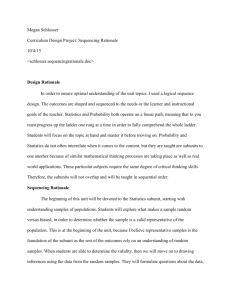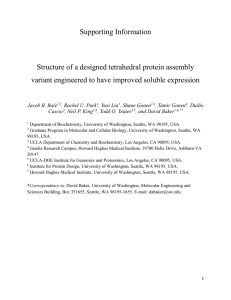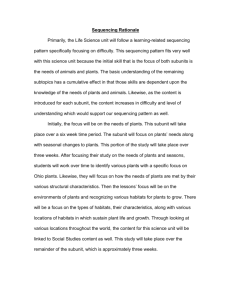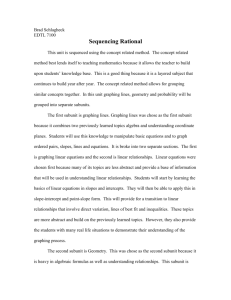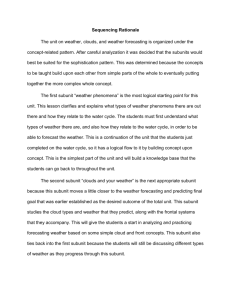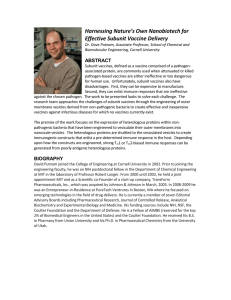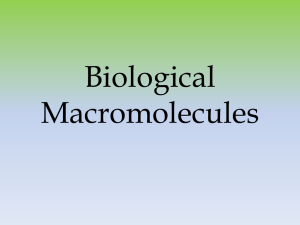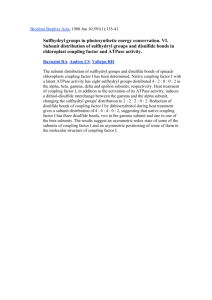Characterization of the Peripheral Stalk of the Vacuolar ATPase-Subunit E
advertisement
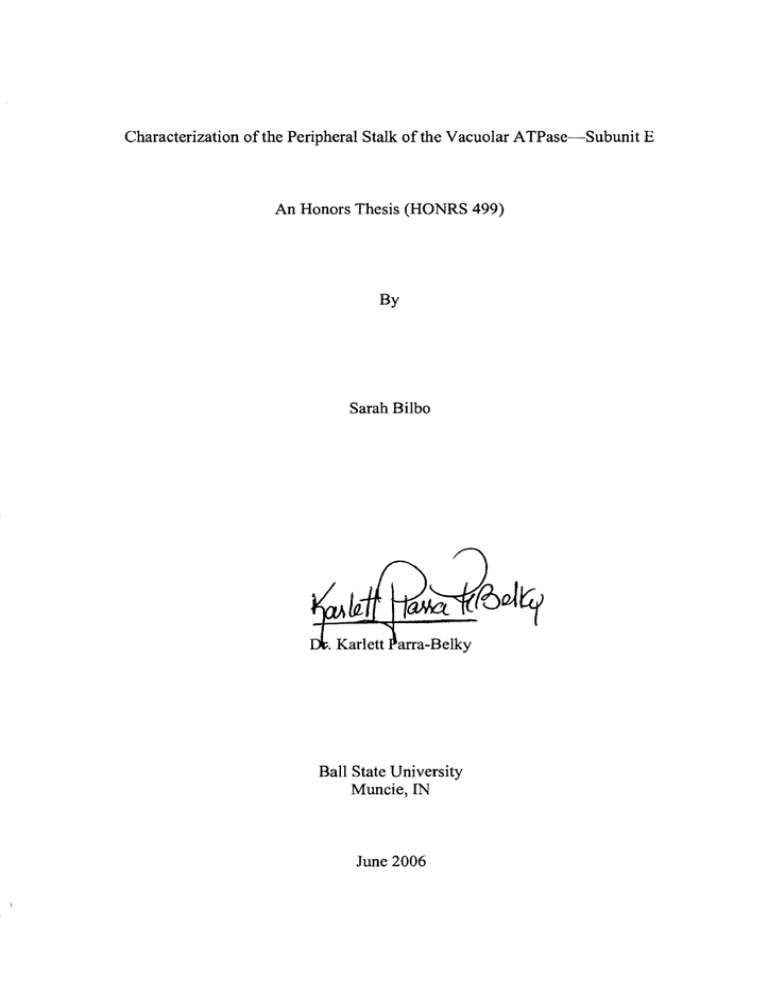
Characterization of the Peripheral Stalk of the Vacuolar ATPase-Subunit E
An Honors Thesis (HONRS 499)
By
Sarah Bilbo
arra-Belky
Ball State University
Muncie, IN
June 2006
pC\,)) )
l-he- / c:-:-,
L f"",
'i LJ
'1
. .,. ~J
ABSTRACT
Be) () G
r-:n
• G .."..-," e#."
V-ATPases are multisubunit ATP-dependent proton pumps consisting of two
('<>I,
f
~
domains: a peripheral VI sector (subunits A-H), which binds and hydrolyses ATP, and a
membrane-bound Vo sector (subunits a, c, c', c", d, and e), which forms the pore to
proton transport. VIand Vo subunits are held together by one central stalk made of
subunits D, F, and one (or two) peripheral stalks made ofe, E, G, H and the N-end of
subunit a.
Subunit E (Vma 4) is a component of VI that forms part of the peripheral stalk
connecting VJ and Yo. Although subunit E is essential for V-ATPase assembly, its
function within the complex is not known. In order to better understand the function of
the peripheral stalk subunit E, site-directed mutations were performed and the analysis of
these mutants is presented here.
2
INTRODUCTION
The vacuolar (H+) ATPases (V-ATPases) are multi subunit complexes found in all
eukaryotic cells (1-8). V -ATPases are responsible for proton transport across
intracellular membrane compartments including lysosomes, endosomes, secretory
vesicles, and golgi-derived vesicles (1-8). Because V-ATPases are essential in processes
like urinary acidification, bone resorption, and pH homeostasis, they are involved in
diseases such as renal tubular acidosis, osteoporosis, and cancer invasiveness (1-8). VATPases operate by a rotary mechanism comparable to F-ATPases (F IFo ATP synthases)
(1-8). Because the organization of the F-ATPase is better understood they offer a useful
model for comparison, however V-ATPases prove to be more complex.
V-ATPases
are composed oftwo functional domains: VI, a peripheral domain of eight subunits (A-H)
that participate in ATP hydrolysis and Yo, the integral domain responsible for
unidirectional proton transport composed of six subunits (a, d, e, c, c', c") (1-8) as seen
in Table 1. The catalytic VI sector, responsible for ATP hydrolysis, faces the cytosolic
region ofthe membrane and is homologous to the FI portion of the F-ATPase. Three A
subunits (70 kDa) and three B subunits (60 kDa) participate in binding and catalytic
hydrolysis of adenosine triphosphate (ATP). These two subunits are homologous to a
and ~ subunits ofF I, subunit A binding ATP and B playing a regulatory role (1-8).
V IVo are attached by one central stalk and two or three peripheral stalks. The
central stalk consists of subunits D and F and the peripheral stalk subunits of C, E, G, and
3
Table 1. V-ATPase Domains and Subunit Information
Gene (in Yeast)
V;\1;\ 1
Vl'vL\ ~
VMA 1:\
VivlA 5
\iMA X
VMA4
VMA7
V\1.\ 10
VPII [iSTV I
VMA6
VMA3
VMA II
Vl\1A 16
VMA9
Subunit
(1\ )
(B)
(II)
( C)
(D)
(E)
0- )
((j )
(a)
(d)
(c)
(c ' )
(c" )
(C)
Mass
6\)-kDa
()()-kDa
S4-kD:l
42-kDa
32-kDa
27-kDa
14-kDa
13-kD,1
[()()-kDa
36-klJa
17-kDa
17-kDa
23-kDa
lO-kDa
Table 1. V-ATPases are composed of two domains. VI is the peripheral portion composed of
eight subunits (A-H) and is responsible for the hydrolysis of ATP. V I is connected by central and
peripheral stalks to V o--the integral domain that provides the unidirectional proton transport
across the membranes and is composed of six different subunits (a, d, c, c', c", e).
4
H (5,6). ATP hydrolysis drives unidirectional proton transport involving Vo subunits a,
c, c', and c". Subunits D, a, c, and F are homologous to F-ATPase subunits ,,(, a, c, and
€
respectively (5,6). However, the remaining subunits lack clear homo logs (E, F, G, H, d)
with FIFo synthases and their roles are not yet understood.
The yeast Sacchromyces cerevisiae provides a model system to explore VATPase proton pumps (3). The subunit E, Vma4, is a 27 kDa protein ofV\ that forms
part of the peripheral stalk(s) connecting VI and Vo and is encoded by the VMA4 gene
(1-8). Subunit E can be crosslinked to subunits B, G, C, and H, suggesting that subunit E
is part of the peripheral stalk (l ,2,4).
Subunit E lacks homolog with the evolutionary related F-ATPase. The role of
subunit E within the complex is not known and of interest in this study. To address the
subunit's role in assembly and activity ofV-ATPases, site-directed mutations were
introduced in highly conserved residues of subunit E. As these evolutionary conserved
residues may be important in the protein structure, variations in size, structure, and
chemical composition may affect subunit E within the V IVo complex. Mutants were
analyzed by examining their growth phenotype, protein stability by whole cell lysis, and
assembly and activity in isolated vacuolar vesicles.
5
EXPERIMENTAL PROCEDURES
Site-Directed Mutagenesis
Site-directed mutagenesis of highly conserved residues of subunit E provides a
method to explore the structural and functional importance of residues for subunit
stability and the role of the subunit within the complex. The V-ATPase Vma4 (subunit
E) protein sequence was found using available protein and gene databases online
(www.yeastgenome.org). The sequence information ofVma4 in other organisms was
compared in order to determine which amino acids were greatly conserved throughout
evolution (Figure 1). These conserved amino acids are most likely crucial for the
subunit's structural and functional stability. Mutating these amino acids within the
sequence will offer some indication of the role of that residue for the subunit and VATPase complex. If conserved residues along the peripheral stalk subunit E are
important for the structural and functional coupling of V I and Yo, site-directed mutations
would affect V-ATPase function and/or assembly.
of subunit E were made, changing amino acids charge, polarity, and/or structure that
could impact the tertiary structure and possibly the function of subunit E within the VATPase complex. In the design of the mutagenic primers, complementary
oligonucleotide sequences containing the individual mutations were made. Primers
contained 25 to 45 bases in length with melting temperatures of greater than or equal to
78°C, determined by the following equation:
Tm = 81.5 + 0.41 (%GC) - 6751N - % mismatch
(Equation 1)
A high percentage of glycine and cysteine (GC) enhanced the chances of proper and
strong annealing due to greater amounts of hydrogen bonding than that between alanine
6
Figure 1. Sequence Alignment of Subunit E
Vma4 A22D, 124N, E27A, A28R,
A32E, A39D, A39N
»I
L
LIVQ 'L -QIMEPKVILRI :E". D.
LVLQ ;L','QLLEPR-·,IVR
L1VE"L KLLEPK -,IVK-
GGV L '
: GGV:, I' "
;- G(?V-,·V
Vma4 S78A, S78C
LV
'RIKV,'NTLE: RL,.LISQQ VF" IRt-: LPG'"
!LIAQQ.·1MP."VR . ,LFG· 1
KIEI>"NTLE: RL'· LLSEE!-Lp:·,:rRl ·LYG
~KIKV:'NTLE:<RL'
"
,RKF D
lRKF. D
RKF~'D
Figure. 1 Shown is the sequence alignment for subunit E from fly, human, and yeast. The blue residues
correspond to fully conserved amino acids in all three species. The red residues are amino acids that have
undergone conservative changes between the species. Site-directed mutations were performed on highly
conserved amino acids shown by highlighted areas.
7
and thymine. Mutations ofVma4 were constructed using QuikChange Site-directed
mutagenesis kit following the manufacturer's protocol. The primers for the Vma4
mutagenesis were constructed as follows with substitution sites underlined:
A22D, 5'
GAACAAGATGCAAGA.TTTCATCAGAAAGGAGCTGAAGAAAAAGCG
I24N, 5'
GAACAAGATGCAAGCTTTCA,ACAGAAGGAGCTGAAGAAAAAGCG
A28R, 5'
GCTTTCATCAGAAAGGAACGTGAAGAAAAAGCGAAGGAAA TCC
A32E, 5'
GGAAGCTGAAGAAAAAG,AGAAGGAAA TCCAATTGAAGGC
3';
3';
3';
3';
E37A, 5'
GATGCAAGCTTTGCTTTCA TCAGAAAGQAGGCTGAAGAAAAAGCG
3';
A39D, 5'
GATGCAAGCTTTGCTTTCATCAGAAAGGAGGA.TGAAGAAAAAGCG
3';
A39N, 5'
GCGAAGGAAA TCCAATTCAAGAATGACCAAGAGT ACG
3';
S78A, 5'
GCTTTCGCAACAGATTACTAAGQCAACGATAGCAAACAAAAATG
3';
S78C,5'
GCTTTCGCAACAGATTACTAAGTGCACGATAGCAAACAAAAATG
3'
Mutations were confinned by sequencing at Ohio State University Plant and Microbe
Genomics Facility and used to transfonn vma4.d yeast strains.
Growth Phenotype
Vacuolar Membrane ATPase (vma) mutants have a pH-sensitive phenotype.
Wild type strains (positive control) and those mutations that do not inhibit greater than
70% of cell activity grow ideally at pH 5. At a pH higher than 7.5 and at pH 7.5 in the
presence of CaCh growth is inhibited. Strains in which a mutation prevents proper
functioning of the V-ATPase and lose more than 70% ofnonnal activity exhibit growth
characteristics similar to the vma4.d strain-a negative control lacking subunit Ebecause they are unable to grow at elevated pH in the presence and absence of calcium.
Mutant strains were grown in SD-Leu pH 5 media at 30°C to 0.5-l.0 OD/ml and
standardized to 0.6 ODs/mt. lO-fold serial dilutions were made with ddH20 and 21lt were
8
plated on pre-warmed (30°C) SD-Leu pH 5, pH 7.5, pH 7.5 + CaCh media and incubated
at 30°C for 24 to 72h.
Whole Cell Lysates
Whole cell lysis provides a means to determine the presence or absence of
proteins within the cell. In this procedure, mutant strains were grown in SD-Leu pH 5
media at 30°C to 0.8-1.0 OD/IlI. Cells were harvested, resuspended in O.IM Tris-HCI pH
9.4 and lOmM DTT, and incubated with rocking at 30°C for five minutes. Cells were
centrifuged and washed twice with 10mM Tris-HCI pH 7.5, I.2M Sorbitol, 2% Glucose
washing solution. Zymolase (lOu/ill) was added to digest the cell wall during 20 minute
incubation at 30°C with rocking. Cells were then washed and resuspended in 10mM
Tris-HCI pH 7.5, 1.2M Sorbitol in order to remove all zymolase. The harvested pellet
was combined with cracking buffer containing 5% B-mercaptoethanol and
bromophenolblue at 50°C for 20 minutes until lysis was complete. Detection of V ATPase subunits is then possible through subjection to SDS-PAGE and Western Blot
techniques with primary and secondary antibodies selective for V-ATPase proteins.
Isolation a/Vacuolar Membrane Vesicles
Vacuolar preparations supply pure isolated vesicles that can be analyzed for VI Vo
complex assembly and activity through concanamycin-sensitive ATPase assays and
Western Blot procedures, respectively. Six liters of cells were grown overnight in SDLeu pH 5 media to a reading of approximately 1.0 OD/mL. Cells were harvested in
cortex tubes at 5000 rpm, washed with 2% Glucose, and resuspended in 1.2M Sorbitol,
2% Glucose, and lOmM Tris-HCl pH 7.5. The pH was checked and if necessary,
adjusted to pH 7-pH 7.5 using Tris-HCI pH 7.5. Zymolase was added (400 VI 4000
9
ODs) and rocked at 150 rpm for at least an hour, until spheroplasts were identified.
Spheroplasts were then centrifuged at 3500 rpm, washed with 1.2M Sorbitol, YEPD pH
5, and resuspended in Buffer A (lOmM MES-Tris pH 6.9, O.lmM MgC12, 12% Ficoll
400) with Aprotinin, Leupeptin, Pepstatin, and PMSF protease inhibitors. Due to the
fragile nature of the spheroplasts after zymolase treatment, every step after this must be
on ice. The solution is homogenized for five minutes with a chilled homogenizer and
transferred to two ultracentrifuge tubes. The tubes are layered with Buffer A, balanced
within 0.01 mL of each other, and spun at 24000 rpm for 35 minutes. The thin layer
remaining on top after this centrifugation is collected and resuspended in 18 mL Buffer
A, homogenized again for five minutes, and transferred to one tube. The solution is
layered with Buffer B (lOmM MES-Tris pH 6.9, 0.5mM MgC12, 8% Fico1l400),
balanced, and spun at 24000 rpm for 35 minutes. The final layer remaining on top after
this centrifugation is collected and resuspended in MES-Tris pH 7.0, 5% glycerol. A
pipette is used to homogenize the suspension and vesicles are aliquoted and stored at 80°C.
Concanamycin-A Sensitive ATPase Assay
Vacuolar vesicles are added to 1 mL cuvettes containing 25mM KCI, 25mM Tris
base, 5mM MgCh, 0.5mM NADH, 2mM PEP, 2mM ATP, 30U/mL L-Iactic
dehydrogenase, and 30U/mL pyruvate kinase, pH 6.9. In this coupled enzymatic assay, a
UV-Visible Spectrophotometer takes measurements every 2 seconds at 340nm, 37°C,
detecting the oxidation ofNADH to NAD+, corresponding with decreased absorbance.
Changes in the level ofNADH are equivalent to the amount of ATP hydrolyzed by the VATPase. Concanamycin-A selectively inhibits ATP hydrolysis by the V -ATPase. By
10
comparing hydrolysis rates of the assay with concanamycin and without concanamycin,
the V-ATPase specific activity of the vesicles can be calculated. To determine the effects
ofa mutation on the V-ATPase activity, values obtained for each mutant were compared
to the wild type.
Other Procedures
Protein Assays-Protein concentrations were determined by the Lowry Method. Bovine
serum albumin was used as standard.
Western Blots- Following SDS-PAGE, proteins from the 10% gels were transferred to
nitrocellulose membranes and incubated overnight with monoclonal antibodies against
subunits A, B, a, and polyclonal antibodies against subunits E, d, and D. Next,
membranes were incubated with alkaline phosphate conjugated secondary antibodies for
two hours. The secondary antibody was then detected through color development after
addition of the substrates 5-bromo-4-chloro-3-indolyl phosphate (BCIP) and nitro blue
tetrazolium (NBT).
11
RESULTS
Subunit E Mutagenesis
Subunit E sequence alignment among evolutionary distant species shows high
conservation of the amino acid sequence at the amino terminus (Figure I). We
hypothesized that these evolutionary conserved residues are likely important for VATPase function and introduced mutations within this region. Site-directed mutations
were made by changing the 22nd, 28 th, 32nd , and 39 th alanine residues to aspartate (A22D),
arginine (A28R), glutamate(A32E), and aspartate (A39D) and asparagine(A39N). The
mutations changed the amino acid side chains from a nonpolar and small methyl group
(alanine) to larger side chains-neutral, polar (asparagine), and charged, basic (arginine),
or charged, acidic (aspartic and glutamic). Additional mutations were introduced that
changed the 24th amino acid (non-polar isoleucine) to a polar asparagine (l24N). The 2ih
residue, glutamic acid was substituted by alanine (E27 A). The 78 th amino acid, a polar
serine was changed to alanine as well as polar cysteine (S78A, S78C, respectively)
(Table 2).
Each mutation was confirmed by sequencing, ensuring that only the desired
mutation was introduced. The effect of these mutations on cell growth, subunit E
stability, and VIVO assembly and function was examined.
Vma4 Mutants S78A and 124N Exhibit Mutant Phenotype
Cell growth characteristics of each mutant strain were compared to the wild type
(positive control), and a vma411 strain carrying the vector pRS315 alone. In order to
determine whether mutants exhibited vma phenotype, cells were grown at pH 5 but not at
pH 7.5, and pH 7.5 + CaCho Of the nine mutants, only S78A and I24N
12
Table 2. Summary of Mutations
I
Mutation
Change in ChemicallPhl::,sical PrORertl::,
A22D
Nonpolar, small alanine~ charged acidic aspartic acid
124N
I
Nonpolar isoleucine
~
I
polar asparagine
I
E27A
Charged acidic glutamic acid~ nonpolar, small alanine
A28R
Nonpolar, small alanine ~ charged basic arginine
A32E
Nonpolar, small alanine ~ charged acidic glutamatic acid
A39D
Nonpolar, small alanine ~ charged acidic aspartatic acid
A39N
Nonpolar, small alanine ~ polar asparagine
S78A
Polar -OR serine~ Nonpolar, small alanine
S78C
Polar -OR serine~ Polar -SR cysteine
I
I
i
I
Table 2. Summary of chemical and/or physical changes resulting from subunit E mutations.
13
exhibited mutant phenotype comparable to the deletion strain (Figure 2). S78A and 124N
cells did not grow at pH 7.S in the presence and absence of CaCh suggesting that less
than 70% of the wild type activity was retained. All the other remaining mutations
showed growth comparable to the wild type.
Subunit E is Destabilized by S78A Mutation
Whole cell lysis followed by SDS-PAGE and Western blotting with antibodies
against V -ATPase subunits was used to determine the stability of the subunits within the
cell. Results were compared to wild type and deletion strains. The mutation S78A
destabilized subunit E as lysates showed significantly lower levels of subunit E than wild
type (Figure 3). All other mutations allowed expression of stable subunits, even 124N
despite its mutant phenotype.
Assembly and Activity of Mutant Membranes
Vacuolar vesicles were isolated from 124N, A28R, S78A, S78C mutant strains as
well as the wild-type and pRS31S strains. Vesicles were used to measure Concanamycin
A-sensitive ATPase, specific activity was calculated, and the results are shown in Table
3.
Additionally, Western blot analyses of vacuolar vesicles were used to detect VI
and Vo subunits at the membranes. It is predicted that mutations in which subunit E is
degraded or destabilized would prevent VI assembly and the complex would be inactive
because deletion of a V I subunit prevents assembly of VI even though Vo is assembled.
14
Figure. 2 Growth Phenotype
48 hours
pH 5
pH 7.5
72 hours
pH 7.5 + eaCh
pH 7.5 + CaCb
WT
pRSJI5
.\221)
I24N
E27.\
A.WI)
:\J9N
AJ2E
\\T
\\T
pRSJl5
S78A
WT
S7SC
Figure. 2 Mutagenesis experiments were performed in vitro using the QuikChange Site-directed
Mutagenesis kit. Mutagenized pRS315-VMA4 was isolated and mutations confirmed by sequencing.
Yeast cells lacking functional endogenous subunit E (vma4L1 cells) were transformed with a wild-type
or mutant allele of the VMA4 gene inserted in the CEN plasmid pRS315. Transformants were
selected on synthetic minimal medium without leucine in the presence of 2% glucose (SD-Leu plates).
Ten-fold dilution growth phenotype was examined at pH 5, 7.5, and pH 7.5 plus 60 mM CaCI2.
15
Figure. 3
Western Blot Analysis of Whole Cell Lysates
Slihunit
Vli~
.... ---""'- ••• ... ............"._-
-•
......m
(\
B
.-
'1202;\11)233/\
ma
-
...
~
...
III
••
- --
-.
.-.
.
pRS315
.II • • S"....
Figure. 3 Cells were converted to spheroplasts by zymolase treatment and lysed at 50°C by addition
of cracking buffer containing SDS, urea, and ~-mercaptoethanol. Cell lysate proteins were separated
in 10% SDS-PAGE and V-ATPase subunits detected by Western Blots using antibodies against
subunits a, A, B, d, D, and E. Western Blot analyses showed nonnal expression and stability of these
subunits with the exception of the S78A, where subunit E was not detected. These results suggest that
the subunit is unstable and possibly degraded due to the mutation. The presence of subunit E in all
other mutant strains suggests that these mutations did not have a major effect on the stability of the
subunit. The mutations described in this study are underlined in black.
16
Table 3. Concanamycin A Sensitive Activity in Mutant and Wild Type Membranes
\ (':1,,1 Strain
-_._,----_._I
Vma4-WT
Vma4A
Vma4-S78A
Vma4 -S78C
Vma4- I24N
Vma4-A28R
PCI-centa Ue ('__
Spl'cific Activitv
!
i
UunoIPilmin/nH!.)
0.1825 ± 0.0282 (n= 7)
0.0142 ± 6.5500e-3 (n= 2)
0.0215 ± 1.5000e-3(n= 2)
0.180 {n=7)
.
Not measurable (n=3)
0.15605 (n=2)
i
100%
7.8%
11.7%
95%
Not Determined
85.5%
...
Table 3. Concanamycin A-sensitive ATPase activity was measured spectrophotometric ally at
37°C using a coupled enzymatic assay. Protein concentrations were determined by the method of
Lowry using bovine serum albumin as the standard. Concanamycin A-sensitive ATPase activity
of each mutant relative to the wild-type is shown (percentage). (n)=number of vacuolar preps.
17
The mutations A28R and S78C retained activity showing wild type functioning
and assembly (Table 3; Figure 4). The results are supported by their growth phenotype
and whole cell lysis analyses that indicate mutations A28R and S78C do not alter the
function of subunit E in the V -ATPase complex. Because subunit E was degraded in the
S78A mutant (Figure 3), VI did not assemble at the membrane (Figure 4), and the enzyme
was inactive (Table 3). As expected, these cells did not grow at pH 7.5 with or without
CaCb, showing that this mutation was detrimental to V IVo assembly and function,
resembling the negative control.
Vesicles from the 124N strain proved to be difficult to isolate (Figure 4). The
preps were scaled up in efforts to increase the yields, yet mutant membranes remained
difficult to isolate and we were unable to analyze it. It is an open question why the
mutation 124N was more damaging to cells than our negative control (pRS315).
18
Figure 4. Western Blot Analysis of Vacuolar Membranes
vma43
WT
§1M
".DO.\
T6.\
U2.l:l.\
a ____...
i Ii..
....iII II.. ...d ~ .....
we.!! ... -r7""
-·---~_.;I_-
__ ""1
m_...
L
"....t-n
T202.\
~I'I
•
(~
-. I
1'9,\
.1 """
J
.
-.".
I
.- -"-I
d - . ~===",-==-==:::'
•
•
I. F
I
·IU.
1
0-.
E-'
..........
• ,p
Figure 4. Cells were converted to spheroplasts by zymolase addition, lysed, and vacuoles isolated by
two ficoll density gradients. Vacuolar membrane vesicles were prepared by diluting the vacuoles in a
10 mM Mes-Tris pH 6.9, 5mM MgCI2, 5% glycerol solution. Vacuoles from wild-type and mutants
strains (10 fg) were analyzed by SDS-PAGE and Western Blots using antibodies against subunits a,
A, B, C, d, D, and E. Mutants discussed in this study are shown underlined in black font.
19
DISCUSSION
In this study, the gene VMA4 was mutagenized. Conserved residues within the
subunit E sequence were changed to residues of different size, structure, and/or chemical
properties to test the hypothesis that conserved residues along the peripheral stalk subunit
E must be important for structural and functional coupling of V 1 and Vo. If our
hypothesis was correct, site directed mutations would have affected V-ATPase function
and/or assembly.
Site-directed mutagenesis provided valuable information about the role of subunit
E within the V-ATPase complex. At the amino end, mutations at Ala-22, Iso-24, Glu-37,
Ala-28, Ala-32, Ala-39, and Ser-78 were made. Growth phenotype analyses were
reproducible. The mutations S78A and I24N exhibited the vma phenotype indicating that
only 20% of the wild type V -ATPase activity or less was retained. These two mutants
were the only ones that had such effect on V -ATPase function. All other mutants
retained significant activity, mimicking the wild type. We concluded that S78 and 124
are residues essential for the enzyme assembly because their mutations were
disadvantageous to cells. As these mutations lie within a highly conserved stretch of the
subunit E sequence, they could participate in interactions with other subunits to sustain
the VIVO complex.
Additionally, the mutant S78C had no vma phenotype, suggesting that replacing the-OB
group with a large -SH group was compatible with VIVO assembly and activity.
Since subunit E was detected in I24N cells, we concluded that the vma phenotype
was not caused by subunit E instability, rather some crucial interactions between the
protein and other subunits within the VIVO complex were affected.
20
Vacuolar preparations of the wild type, pRS315, I24N, A28R, S78A, and S78C
mutants provided vesicles that contained V -ATPase complexes. Isolated vacuolar
vesicles provided information on V-ATPase activity and VIVO assembly. A28R and
S78C mutant membranes had specific activities of 0.15605 and 0.180 Ilmol Pi/min/mg,
respectively that resembled the wild type (Table 2). Viand Vo subunits were visualized
by Western blots, indicating that VIVO complexes were assembled (Figure 4). These
experiments indicate that the mutations did not have a major effect on the function of
subunit E within the complex.
On the other hand, the specific activity ofS78A was 0.0142 Ilmol Pi/min/mg
(Table 2). The mutation that changed Ser-78 to alanine destabilized subunit E suggesting
that changing the polar residue to a nonpolar methyl group prevents important
interactions involving the subunit E. Consequently, in the absence of subunit E, V I did
not assemble and the VIVO complex could not be formed, leaving only assembled Vo at
the membrane.
The extremely low yields of vesicles carrying mutation I24N did not allow
measurement of ATP hydrolysis and their Western blots analysis showed no proteins.
Further studies need to address why I24N had such a drastic effect on the vacuolar
preparation. In addition, vacuolar preparations need to be performed for the remaining
mutant strains A22D, A32E, E37 A, A39D, and A39N. Although these mutants lack
mutant phenotype, and whole cell lyses results suggest that these mutations did not
destabilize subunit E and allowed for significant VIVO assembly and activity, vacuolar
membranes have to be studied and their specific activity determined.
21
In conclusion, the mutation S78A was unique because it caused degradation or
destabilization of subunit E, preventing the V-ATPase from functioning properly. I24N
was particularly interesting because only traces of membranes could be isolated. These
results suggest that subunit E interactions within the complex are crucial for the VATPase to operate effectively. That S78C resembled wild type in assembly and activity,
suggests that the polar interactions at Ser-78 are necessary for function and stability.
Although still inconclusive, the 124N mutant will offer some interesting insights about
the need of a nonpolar residue at this position.
22
ACKNOWLEDGEMENTS
I sincerely thank Dr. Karlett Parra-Belky for all her time, guidance, and for the
opportunity to be part of this research. I would also like to thank Ball State University
Department of Chemistry and everyone working in the laboratory-they have provided
so much support and help that made this work possible.
23
REFERENCES
1. Arata, Y., Baleja, J. D., and Forgac, M. (2002) Biochern. 41 (37)11301-11307
2. Arata, Y, Baleja, J. D., and Forgac, M. (2001) J Bioi. Chern. 277 (5)3357-3363
3. Curtis, K.K., Francis, S.A., Oluwatosin, Y., and Kane, P.M. (2002) J Bioi. Chern.
277 (11) 8979-8988
4. Fethiere, J., Venzke, D., Diepholz, M., Seybert, A., Geerlof, A., Gentzel, M.,
Wilm, M., and Bottcher, B. (2004) J Bioi. Chern. 3940670-40676
5. Inoue, T. Wilkins, S., and Forgac, M. (2003) J Bioenerg. Biornernbr. 35 (4),
291-299
6. Kawasaki-Nishi, S., Nishi, T., Forgac, M. (2003) FEBS Lett. 54576-85
7. Liu, M., Tariso, M., Charsky, C.M.H., and Kane, P.M. J Bioi. Chern. 280 (44)
36978-36985
8. Owegi, MA, Carenbauer, AL, Wick NM, Brown JF, Terhune KL, Bilbo SA,
Weaver, RS, ShircliffR, Newcomb N, Parra-Belky KJ. (2005) JBiol.Chern. 280
(18), 18393-18402.
24
